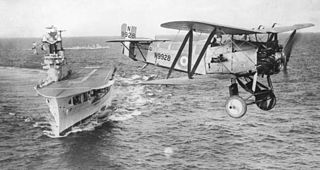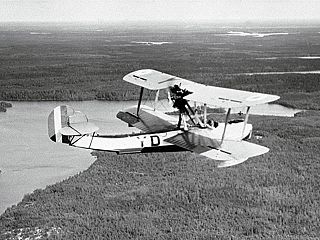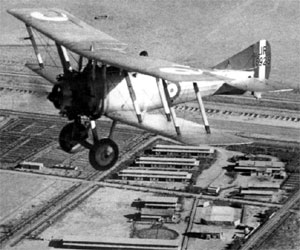
The Avro 504 is a single-engine biplane bomber made by the Avro aircraft company and under licence by others. Production during World War I totalled 8,970 and continued for almost 20 years, making it the most-produced aircraft of any kind that served in any military capacity during the First World War. More than 10,000 were built from 1913 until production ended in 1932.

The Blackburn Shark was a carrier-borne torpedo bomber designed and built by the British aviation manufacturer Blackburn Aircraft. It was originally known as the Blackburn T.S.R., standing for "torpedo-spotter-reconnaissance", in reference to its intended roles. The Shark was the last of Blackburn's biplane torpedo bombers.

The Fairey Flycatcher was a British single-seat biplane carrier-borne fighter aircraft made by Fairey Aviation Company which served from 1923 to 1934. It was produced with a conventional undercarriage for carrier use, although this could be exchanged for floats for catapult use aboard capital ships.

The Gloster Grebe was developed by the Gloster Aircraft Company from the Gloster Grouse, and was the Royal Air Force's first post-First World War fighter aircraft, entering service in 1923.

The Hawker Woodcock was a British single-seat fighter built by the Hawker Engineering Company as the first fighter to be produced by Hawker Engineering. It was used by the Royal Air Force (RAF) as a night fighter in the 1920s.

The Avro Type 621 Tutor is a two-seat British radial-engined biplane from the interwar period. It was a simple but rugged basic trainer that was used by the Royal Air Force as well as many other air arms worldwide.

The Canadian Vickers Vedette was the first aircraft designed and built in Canada to meet a specification for Canadian conditions. It was a single-engine biplane flying boat purchased to meet a Royal Canadian Air Force (RCAF) demand for a smaller aircraft than the Vickers Viking with a much greater rate of climb, to be suitable for forestry survey and fire protection work. The type went on to have a long and distinguished career in civil operations in Canada. Most of the topographical maps in use in Canada today are based on photos taken from these aircraft.

The Canadian Vickers Vanessa was a Canadian biplane transport floatplane of the 1920s evaluated by the Royal Canadian Air Force (RCAF) and used briefly for delivering air-mail.

The Armstrong Whitworth A.W.14 Starling was a prototype British single-seat biplane fighter developed for the Royal Air Force in the late 1920s which unsuccessfully competed against the Bristol Bulldog.

The Avro 627 Mailplane was a British biplane developed in 1931 by Avro from the Avro Antelope bomber as a mail plane for use in Canada. Only one was built which ended up being used as a test bed.
The Avro 636 was a single-engined British fighter-trainer built by Avro in the mid-1930s. Four were built for the Irish Air Corps.

The Avro 701 Athena is a British advanced trainer aircraft built by Avro in the late 1940s. It was designed to replace the North American Harvard in the Royal Air Force, but was bought only in small numbers, the competing Boulton Paul Balliol being preferred.

The Blackburn F.2 Lincock was a British single-seat lightweight fighter produced by Blackburn Aircraft Limited.

The Gloster SS.35 Gnatsnapper was a British naval biplane fighter design of the late 1920s. Two prototypes were built but the type did not enter production.

The Cierva C.8 is an experimental autogyro built by Juan de la Cierva in England in 1926 in association with Avro. Like Cierva's earlier autogyros, the C.8s were based on existing fixed-wing aircraft fuselages – in this case, the Avro 552.

The Nieuport Nighthawk was a British fighter aircraft developed by the Nieuport & General Aircraft company for the Royal Air Force towards the end of the First World War. Although ordered into production before the aircraft first flew, it did not enter large scale service with the RAF owing to unreliable engines. Re-engined aircraft did see service in Greece, serving from 1923 to 1938.

The Saro Cloud was a British passenger amphibian flying boat designed and built by Saunders-Roe as the A.19. It was later produced as the A.29 for the Royal Air Force for pilot and navigator training.

The Gloster Grouse was a British biplane of the 1920s developed by the Gloster Aircraft Company. Often referred to as the prototype to the Gloster Grebe, the Grouse originally built as an experimental aircraft and then later developed as a trainer. Despite its compact design and maneuverability, the Grouse was not in itself a commercial success, although it formed the basis for the Gloster Grebe and Gamecock fighters which were used by Britain's Royal Air Force into the 1930s.
The Westland Wagtail was a prototype British fighter aircraft of the First World War. A single-engined tractor biplane, the Wagtail was a failure owing to the unreliability of its engine, only five being built.

The Vickers Vireo was an experimental low wing all-metal monoplane built to explore both all-metal service aircraft and the use of catapult launched ship board fighters. Only one was built.


















